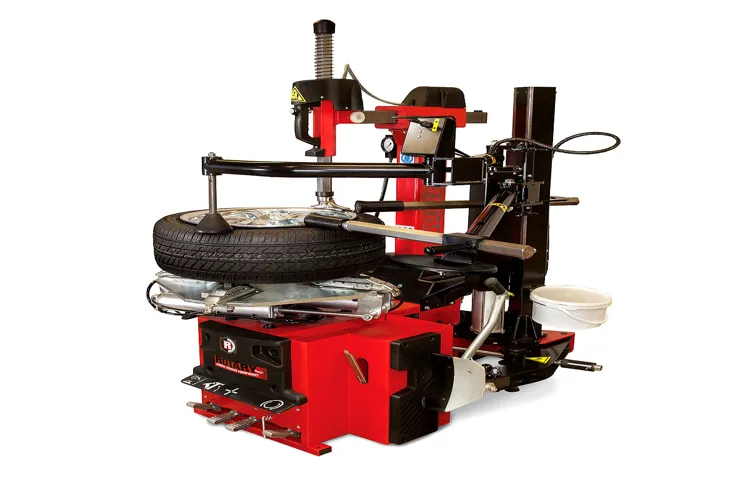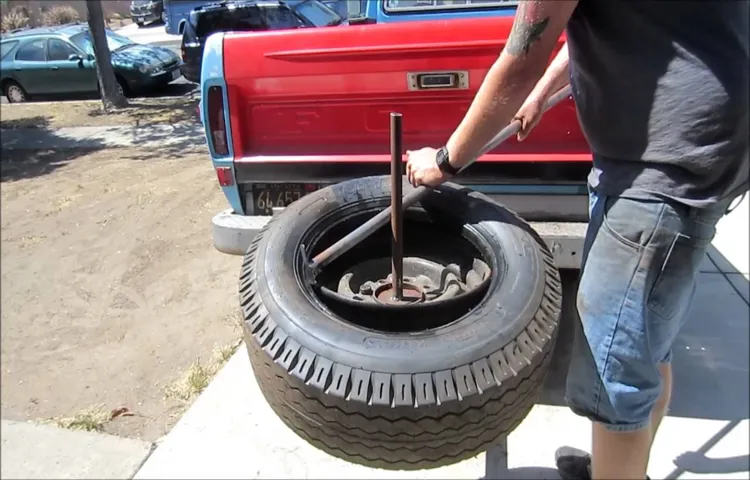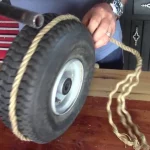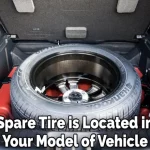Changing a tire can be a pain, and it’s not something we want to spend our precious time on. Imagine being in a rush to get to an important meeting or picking up your kids from school, only to realize that your tire is flat. You might feel frustrated or overwhelmed, but don’t worry, that’s where tire changing machines come in! In this blog post, we’ll show you step-by-step how to use a tire changing machine to make your life easier and ensure that you’re back on the road in no time.
So, buckle up and let’s get started!
Table of Contents
Introduction: Understanding Tire Changing Machine
If you’ve ever found yourself in need of changing a tire, then you know how frustrating it can be. It’s even worse if you don’t have the right tools, like a tire changing machine. A tire changing machine is a piece of equipment that is specifically designed to make the tire changing process easier, faster, and safer.
Knowing how to use a tire changing machine can make a huge difference in your ability to get back on the road quickly and without any unnecessary stress. The process is quite simple. First, you need to remove the tire from the vehicle and place it on the machine.
Then, use the machine’s various components to break the bead, remove the old tire, install the new tire, and then re-inflate it. With the right know-how, you can save yourself a lot of time and frustration the next time you find yourself with a flat tire.
Definition of a Tire Changing Machine
A tire changing machine is a piece of equipment used to remove and install tires on vehicles. It is a valuable tool for automotive workshops and repair shops because it simplifies the process of replacing worn-out tires. A tire changing machine typically includes a tire changer, which removes the tire from the wheel rim, and a wheel balancer, which restores the balance of the wheel assembly.
The tire changer uses mechanical devices to aid in the removal and installation of tires. Some tire changing machines are fully automated and can be operated with minimal manual labor, whereas others require skilled operators to use them. It’s important to note that tire changing machines come in different types and sizes, each designed to handle specific types of vehicles and tire sizes.
Whether you’re a professional mechanic or a DIY enthusiast, using a tire changing machine can save you time, effort, and money in the long run.

Types of Tire Changing Machine
If you’re in the automotive industry, you know the importance of having a reliable tire changing machine. These machines are designed to help with the process of removing and installing tires, making it faster and easier for mechanics to complete their work. There are several types of tire changing machines available, each with their own unique features and capabilities.
Some of the most common types include manual tire changers, automatic tire changers, and semi-automatic tire changers. Manual models require more physical effort from the operator, but they’re usually more affordable. Automatic options are more expensive, but they require less effort and can be more efficient.
Semi-automatic machines are a good middle ground, offering some manual control with some automation features. No matter which type of tire changing machine you choose, be sure to select one that meets your needs and budget, and is the right fit for your shop.
Step by Step Guide for Using a Tire Changing Machine
If you’re eager to save time and money, a tire changing machine can be an invaluable addition to your garage or workshop. However, it’s important to know how to use a tire changing machine properly to ensure safety and successful results. Here’s a step by step guide on how to use a tire changing machine.
First, secure the tire machine to the floor using bolts. Secondly, immerse the tire in water to soften the rubber and create a good seal. Next, position the tire machine in a level position with the bead breaker arm facing the tire’s sidewall.
Using the bead breaker arm, break the tire bead loose by sliding it along the sidewall until it snaps. Then, lubricate the bead and use the tire machine to mount the tire on the rim. Finally, inflate the tire to the recommended pressure and check for leaks.
Voila! You have successfully changed a tire using a tire changing machine. By following these simple steps, you can now replace your old and worn-out tires in no time.
Step 1: Preparations.
Using a tire changing machine for the first time can be overwhelming, but following a step-by-step guide can make the process easy and efficient. The first step is to prepare the machine and the vehicle. Begin by ensuring that the machine is in good working condition and all necessary tools and equipment are at hand.
Adjust the height of the machine to match the tire size and weight of the vehicle. The next step is to locate the jacking points and secure the vehicle in place. Use a torque wrench to loosen the lug nuts and remove the flat tire.
Before installing the new tire, make sure the wheel is free of debris and corrosion. Place the tire onto the machine’s turntable, ensuring it’s properly aligned with the mounting studs. Activate the machine and let it do the heavy lifting, while you guide the tire onto the studs and tighten the lug nuts.
By following these simple steps, you can safely and effectively use a tire changing machine, making the entire process hassle-free.
Step 2: Mount the Tire onto the Wheel Changer.
Now that you’ve prepped the tire, it’s time to mount it onto the wheel changer. This is where the real magic happens! First, position the wheel onto the machine and secure it into place. This can be done manually or with the help of the machine itself.
Once it’s secure, take the tire and carefully align it with the rim of the wheel. This is where you can really put your arm strength to the test. Use your hands to push and pull the tire into place, being mindful not to damage the material.
Once the tire is snug, it’s time to add air. But don’t just go willy-nilly with the air compressor! Check the manufacturer’s recommendations for the proper air pressure, and make sure to inflate the tire evenly across the rim. This step is crucial in ensuring that the tire is safe and balanced for the road ahead.
And just like that, your tire is securely mounted and ready to roll!
Step 3: Demount the Old Tire.
The third step in using a tire changing machine is to demount the old tire. This involves removing the tire from the rim. Once the tire is in the tire-changing machine, make sure the wheel is in a stable position.
You should then remove the air pressure from the tire by unscrewing the valve core. Take care not to let the core fly off, as it can be difficult to find. Next, use the demounting tool to break the tire’s bead and separate it from the rim.
It is important to be careful when using this tool, as there is a risk of damaging the rim if it is mishandled. Once you have broken the bead, you can use the lever to pull the tire away from the rim. Ensure the tire is fully detached before moving onto the next step.
This can be a tough process, but with the right tools and patience, you can demount the old tire without incident. Remember, safety should always come first when working with tires, so take your time and stay alert.
Step 4: Install the New Tire.
After you have successfully removed the old tire off the rim using the tire-changing machine, it is now time to install the new tire. Carefully align the tire onto the rim, ensuring that it fully seats onto the rim by pressing it down with your hands. Next, place the rim and tire assembly onto the machine and secure it using the clamps.
Use the machine to inflate the tire to the recommended pressure level. Lastly, check the tire’s orientation and balance to ensure the tire is mounted correctly onto the rim. Once you have checked everything, you’re almost done! Lower the tire-changing machine’s arm and release the clamps.
Voila! You have successfully changed your tire. Remember, safety is key when using a tire-changing machine, so always wear protective gear and follow the machine’s instructions carefully. Changing a tire can be a daunting task, but with the right technique and equipment, it can be a breeze.
Safety Tips When Using a Tire Changing Machine.
If you are changing tires regularly, then you’re probably using a tire changing machine. These machines will not only make your work faster and more efficient but can also make it much safer. However, using a tire changing machine can be dangerous if you don’t follow safety guidelines.
First and foremost, read and understand the manufacturer’s instructions before using the machine. Then, ensure that the machine is placed on a stable and level surface. Always wear protective gear, such as gloves and goggles.
It is also important to position your body away from the path of the tire and wheel as they are being removed or installed. Additionally, never inflate the tire over the recommended pressure to avoid the risk of explosions. By following these safety guidelines, you can be sure to use the tire changing machine effectively.
Always Wear Personal Protective Equipment
One of the most important safety tips when using a tire changing machine is to always wear personal protective equipment. This includes gloves, eye protection, and appropriate clothing. While tire changing machines make the process of changing tires easier and faster, they can also be dangerous if not used properly.
Protecting yourself from potential hazards is essential to ensure that you aren’t injured while using these machines. Additionally, it’s important to follow all safety instructions and guidelines provided by the manufacturer. Remember, accidents can happen even when taking all necessary precautions, so always keep a first aid kit nearby just in case.
By wearing personal protective equipment and following recommended safety procedures, you can avoid potentially serious injuries while using a tire changing machine. Stay safe and happy tire changing!
Make Sure the Tire Changer is Stable and Secure.
When it comes to using a tire changing machine, the number one priority is safety. Before starting, it’s important to make sure the tire changer is stable and secure. A wobbly machine increases the chances of accidents, which is why it’s crucial to check the stability of the equipment.
Also, don’t overload the tire changer, as it can lead to instability and cause the machine to tip over. It’s essential to ensure that the machine’s weight capacity is not exceeded by the vehicle’s weight. Additionally, make sure to wear appropriate safety gear, such as gloves, eye protection, and sturdy shoes, to avoid injuries.
Keeping these tips in mind will help you use a tire changing machine safely and successfully.
Never Force the Tire on the Machine.
When using a tire changing machine, safety should always be a top priority. One of the most important safety tips is to never force the tire onto the machine. This may seem like common sense, but it’s easy to get impatient when trying to change a tire quickly.
However, forcing the tire onto the machine can cause the tire to explode, which can result in serious injury or even death. Instead, take your time and make sure that the tire is properly seated on the machine before proceeding. Additionally, be sure to follow all of the manufacturer’s instructions and use the appropriate tools to ensure that the tire changing process goes smoothly.
By taking these precautions, you can help ensure that you stay safe while using a tire changing machine.
Conclusion: Maintaining Your Tire Changing Machine.
It’s a common misconception that changing a tire is a laborious chore meant only for the seasoned gearhead. But fear not, dear reader, for with the help of a tire changing machine, it’s as easy as pressing a button. In just a few simple steps, you can swap out your flat for a fresh new tire without breaking a sweat or breaking the bank.
So don’t let a flat tire deflate your spirits. Keep calm and change on with the power of technology on your side.”
Regular Maintenance and Cleaning
Regular tire changing machine maintenance and cleaning are essential for both the machine’s longevity and the safety of the operator. It’s crucial to inspect the machine before use and maintain a clean working area to avoid any accidents. The operator must wear safety gear such as gloves and goggles.
When changing a tire, the machine’s power source must be disconnected to prevent any electrical accidents. The machine’s manufacturer instructions must be strictly followed, and the correct attachments and tools must be used. It’s also important to inspect tires for any damages before changing them and lifting the vehicle per the manufacturer’s instructions.
Regular cleaning of the machine ensures the removal of any dirt or debris that may affect its performance or cause accidents. Remember, a well-maintained tire changing machine is a safe tire changing machine. Keep your machine in good working condition and follow all safety tips to ensure a successful and accident-free tire change.
Regular Inspection
Regular inspection is crucial when using a tire changing machine to ensure safety. Before using the machine, it’s essential to check the equipment for any cracks, bends, or wear and tear on the moving parts. A thorough inspection helps prevent any accidents that could occur if the machine isn’t functioning correctly.
Always make sure that the machine is stable and secure before using it, ensuring that the legs or wheels are in good condition. Additionally, it’s crucial to use the correct tools when working with the machine to prevent any damage to the parts or injury to the operator. Performing regular inspections can identify potential issues early before they become major problems, saving time, money, and keeping businesses running smoothly.
Don’t forget to record the inspection in logs, identifying any repairs or maintenance undertaken. Regular maintenance and upkeep of a tire changing machine can increase its lifespan and improve safety conditions for operators. It’s important to prioritize safety first, always checking the equipment, and performing timely maintenance to reduce the risk of accidents.
Following the Manufacturer’s Instructions.
When it comes to using a tire changing machine, it’s critical to follow the manufacturer’s instructions for safe operation. One of the most important safety tips is to make sure the machine is securely bolted to the ground or a stable workbench to prevent it from tipping over. Always wear gloves and eye protection to prevent injuries from sharp or flying debris.
Familiarize yourself with the machine’s controls before use, as they may vary between models. Remember to never exceed the machine’s specified weight limit or attempt to change a tire that’s too large for the machine. By following these precautions and heeding the manufacturer’s instructions, you can safely and confidently operate a tire changing machine to efficiently change your vehicle’s tires.
FAQs
What is a tire changing machine?
A tire changing machine is a piece of equipment used to remove and install tires on wheels.
How does a tire changing machine work?
A tire changing machine uses a combination of levers, clamps, and air pressure to remove and install tires.
Can I use a tire changing machine at home?
Yes, there are tire changing machines designed for home use, although they may not be as powerful or efficient as those used in professional garages.
Do I need special training to use a tire changing machine?
While it’s not strictly necessary, it’s highly recommended that you receive training on how to properly use a tire changing machine to avoid injury or damage to your vehicle.
How long does it take to change a tire using a tire changing machine?
It depends on the type of machine and your level of experience, but it generally takes between 10-30 minutes to change a tire using a tire changing machine.
What are the benefits of using a tire changing machine?
Some of the benefits of using a tire changing machine include increased safety, efficiency, and accuracy, as well as reduced physical strain and risk of damage to the tire or wheel.
Can a tire changing machine be used on all types of vehicles?
Most tire changing machines can be used on a wide range of vehicles, but certain models may have size or weight limitations, so it’s important to consult the machine’s manual before use.



